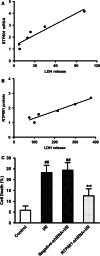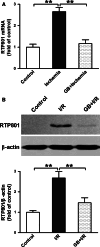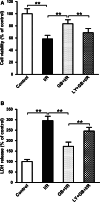Ginkgolide B Protects Neurons from Ischemic Injury by Inhibiting the Expression of RTP801
- PMID: 25869596
- PMCID: PMC11486257
- DOI: 10.1007/s10571-015-0189-3
Ginkgolide B Protects Neurons from Ischemic Injury by Inhibiting the Expression of RTP801
Abstract
RTP801 (also known as REDD1), a stress-related protein, is induced by several environmental stresses such as ischemia and cigarette smoke. Although ischemia can dramatically up-regulate RTP801 expression in brain ischemia, up to now, the exact relation between RTP801 and neuronal death in ischemia is poorly understood. In the current study, using oxygen and glucose deprivation as an in vitro ischemic model in primary cultured cortical neurons, we found that the expression of RTP801 increased progressively with prolongation of ischemic duration, in which the expression of RTP801 is positively correlated with the release of lactate dehydrogenase (LDH) in neurons, and knockdown of RTP801 promoted neuronal survival in ischemia-reperfusion. It was further found that ginkgolide B (GB) could significantly increase cell viability and decrease LDH release, and at the same time reduce the levels of RTP801 mRNA and protein in neurons after ischemia and reperfusion. Moreover, GB-induced reduction in expression of RTP801 was blocked by application of LY294002, a specific inhibitor of phosphatidylinositol 3-kinase (PI3K). These results demonstrate that RTP801 could play a detrimental role on neurons in ischemia, and GB might protect neurons against ischemic injury by inhibiting RTP801 expression via PI3K pathway.
Keywords: Ginkgolide B; Ischemia; Ischemia–Reperfusion; Neuron; Phosphatidylinositol 3-kinase; RTP801.
Conflict of interest statement
The authors state no conflict of interest.
Figures





Similar articles
-
Antioxidant effects of ginkgolides and bilobalide against cerebral ischemia injury by activating the Akt/Nrf2 pathway in vitro and in vivo.Cell Stress Chaperones. 2019 Mar;24(2):441-452. doi: 10.1007/s12192-019-00977-1. Epub 2019 Feb 27. Cell Stress Chaperones. 2019. PMID: 30815818 Free PMC article.
-
Neuroprotective effect of Ginkgolide K against H2O2-induced PC12 cell cytotoxicity by ameliorating mitochondrial dysfunction and oxidative stress.Biol Pharm Bull. 2014;37(2):217-25. doi: 10.1248/bpb.b13-00378. Epub 2013 Nov 12. Biol Pharm Bull. 2014. PMID: 24225258
-
Neuroprotective effects of Ginkgo biloba extract and Ginkgolide B against oxygen-glucose deprivation/reoxygenation and glucose injury in a new in vitro multicellular network model.Front Med. 2018 Jun;12(3):307-318. doi: 10.1007/s11684-017-0547-2. Epub 2017 Oct 2. Front Med. 2018. PMID: 29058254
-
Pharmacological studies supporting the therapeutic use of Ginkgo biloba extract for Alzheimer's disease.Pharmacopsychiatry. 2003 Jun;36 Suppl 1:S8-14. doi: 10.1055/s-2003-40454. Pharmacopsychiatry. 2003. PMID: 13130383 Review.
-
[Ginkgolide B: mechanisms of neurobiological effects, prospects for use in the therapy of Alzheimer's disease].Zh Nevrol Psikhiatr Im S S Korsakova. 2024;124(4):22-27. doi: 10.17116/jnevro202412404122. Zh Nevrol Psikhiatr Im S S Korsakova. 2024. PMID: 38676673 Review. Russian.
Cited by
-
Identification of ginkgolide targets in brain by photoaffinity labeling.Chem Biol Drug Des. 2017 Apr;89(4):475-481. doi: 10.1111/cbdd.12883. Epub 2016 Nov 10. Chem Biol Drug Des. 2017. PMID: 27743504 Free PMC article.
-
Ginkgolide B promotes the proliferation and differentiation of neural stem cells following cerebral ischemia/reperfusion injury, both in vivo and in vitro.Neural Regen Res. 2018 Jul;13(7):1204-1211. doi: 10.4103/1673-5374.232476. Neural Regen Res. 2018. PMID: 30028328 Free PMC article.
-
Time-Course Change of Redd1 Expressions in the Hippocampal CA1 Region Following Chronic Cerebral Hypoperfusion.Cell Mol Neurobiol. 2017 Apr;37(3):563-569. doi: 10.1007/s10571-016-0385-9. Epub 2016 May 27. Cell Mol Neurobiol. 2017. PMID: 27233899 Free PMC article.
-
The neuroprotective mechanisms of ginkgolides and bilobalide in cerebral ischemic injury: a literature review.Mol Med. 2019 Dec 21;25(1):57. doi: 10.1186/s10020-019-0125-y. Mol Med. 2019. PMID: 31864312 Free PMC article. Review.
-
Salvianolic Acid B Ameliorates Cerebral Ischemia/Reperfusion Injury Through Inhibiting TLR4/MyD88 Signaling Pathway.Inflammation. 2016 Aug;39(4):1503-13. doi: 10.1007/s10753-016-0384-5. Inflammation. 2016. PMID: 27255374
References
-
- Bate C, Kempster S, Williams A (2006) Platelet-activating factor antagonists protect amyloid-beta damaged neurons from microglia-mediated death. Neuropharmacology 51(2):173–181 - PubMed
-
- Chung HS, Harris A, Kristinsson JK, Ciulla TA, Kagemann C, Ritch R (1999) Ginkgo biloba extract increases ocular blood flow velocity. J Ocul Pharmacol Ther 15(3):233–240 - PubMed
-
- Fang D, Li Z, Zhong-ming Q, Mei WX, Ho YW, Yuan XW, Ya K (2008) Expression of bystin in reactive astrocytes induced by ischemia/reperfusion and chemical hypoxia in vitro. Biochim Biophys Acta 1782(11):658–663 - PubMed
-
- Fang W, Deng Y, Li Y, Shang E, Fang F, Lv P, Bai L, Qi Y, Yan F, Mao L (2010) Blood brain barrier permeability and therapeutic time window of ginkgolide B in ischemia–reperfusion injury. Eur J Pharm Sci 39(1–3):8–14 - PubMed
Publication types
MeSH terms
Substances
LinkOut - more resources
Full Text Sources

